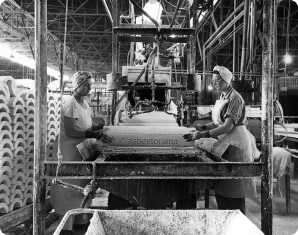Asbestos Ban in the U.S.
1989年7月12日,美国vironmental Protection Agency issued a final rule to ban the majority of asbestos products. However, it was overturned and asbestos is still imported from other countries.
Written byJoe Lahav, Esquire•Edited ByWalter Pacheco•Legally Reviewed ByWilliam A. Davis
Asbestos.com is the nation’smost trustedmesothelioma resource
The Mesothelioma Center at Asbestos.com has provided patients and their loved ones the most updated and reliable information on mesothelioma and asbestos exposure since 2006.
Our team of Patient Advocates includes a medical doctor, a registered nurse, health services administrators, veterans, VA-accredited Claims Agents, an oncology patient navigator and hospice care expert. Their combined expertise means we help any mesothelioma patient or loved one through every step of their cancer journey.
30多个贡献者,包括间皮瘤doctors, survivors, health care professionals and other experts, have peer-reviewed our website and written unique research-driven articles to ensure you get the highest-quality medical and health information.
About The Mesothelioma Center at Asbestos.com
- Assisting mesothelioma patients and their loved ones since 2006.
- Helps more than 50% of mesothelioma patients diagnosed annually in the U.S.
- A+ rating from the Better Business Bureau.
- 5-star reviewed mesothelioma and support organization.
Testimonials
My family has only the highest compliment for the assistance and support that we received from The Mesothelioma Center. This is a staff of compassionate and knowledgeable individuals who respect what your family is experiencing and who go the extra mile to make an unfortunate diagnosis less stressful. Information and assistance were provided by The Mesothelioma Center at no cost to our family.LashawnMesothelioma patient’s daughter
How to Cite Asbestos.com’s Article
APA
Lahav, J. (2023, July 21).Asbestos Ban in the U.S..Asbestos.com. Retrieved September 28, 2023, from //www.magnakarsa.com/mesothelioma-lawyer/legislation/ban/
MLA
Lahav, Joe. "Asbestos Ban in the U.S.."Asbestos.com, 21 Jul 2023, //www.magnakarsa.com/mesothelioma-lawyer/legislation/ban/.
Chicago
Lahav, Joe. "Asbestos Ban in the U.S.." Asbestos.com. Last modified July 21, 2023. //www.magnakarsa.com/mesothelioma-lawyer/legislation/ban/.
Is Asbestos Banned in the United States?
No, asbestos is not banned in the U.S. While attempts have been made to ban it over the years, the U.S. continues to import and use asbestos. Nearly 114 metric tons of asbestos were imported in the first three months of 2022, according to the United States International Trade Commission, exceeding the 100 metric tons imported in all of 2021. Although imports continue, asbestos has not been mined in the U.S. since 2002.
Asbestos stopped being used in most industries and products by the late 1970s. Limits on asbestos and other toxic pollutants were put into place following passage of the Toxic Substances Control Act of 1976. Other factors, such as demands by organized labor and trade groups for safer work environments, also contributed to the steep decline in asbestos use as manufacturers sought other alternatives.
We now know for certain that all forms of asbestos can causemesothelioma, lung cancer and other chronic respiratory conditions. As early as the 1960s, Dr. Irving J. Selikoff conclusively linkedasbestosto certain diseases, including mesothelioma and lung cancer, providing the evidence needed to counteract the substantial influence of the asbestos industry.
OSHA defines asbestos-containing materials as any material that contains more than 1% asbestos. This means any material can be labeled asbestos-free if asbestos accounts for less than 1% of the product.
Attempts to Ban Asbestos in the U.S.
In July 1989, the EPA issued theAsbestos Ban and Phase-Out Rule, which would have imposed a full ban on the manufacturing, importation, processing and sale of asbestos-containing products. The EPA also banned new uses of asbestos, which would have forbidden new asbestos-containing products from being distributed after Aug. 25, 1989.
To date, ABPR remains the best attempt at a federal ban of asbestos. Unfortunately, the legislation was short-lived. The ABPR ignited a fierce counterattack from the asbestos industry. Critics of the rule said the ban would lead to “death by regulation” and pointed to potential job losses and economic consequences.

Asbestos product manufacturers filed a lawsuit against the EPA in the landmark case Corrosion Proof Fittings v. Environmental Protection Agency. On Oct. 18, 1991, the United States Court of Appeals for the Fifth Circuit overturned the ban, claiming the agency failed to demonstrate that a ban was the “least burdensome alternative” to regulating asbestos. Guided by the George H.W. Bush Administration, the agency didn’t appeal the ruling.
The EPA did receive clarification from the court that the ban could apply to asbestos products that were not being manufactured, processed or imported on July 12, 1989, which was the day the agency announced the ABPR. It was determined that six categories of asbestos-containing products fit that classification.
- Flooring felt
- Rollboard
- Commercial paper
- Corrugated paper
- Specialty paper
- New uses of asbestos
The ABPR followed an announcement in 1980 from the National Institute for Occupational Safety and Health, also known as NIOSH, that: “All levels of asbestos exposure studied to date have demonstrated asbestos-related disease … there is no level of exposure below which clinical effects do not occur.”
U.S. Legislation Regulating Asbestos
Throughout the 1970s and 1980s, the following legislation regulating the use of asbestos was implemented.
- Asbestos Hazard Emergency Response Act of 1986:Required the EPA to establish standards for inspecting and removingasbestos in schools.
- Toxic Substances Control Act of 1976:Provided the EPA with the authority to place restrictions on certain chemicals such as asbestos, radon and lead-based paint.
- Medical Device Amendments of 1976:Allowed the U.S. Food and Drug Administration to ban the use of asbestos-containing filters in pharmaceutical manufacturing, processing and packaging.
- Consumer Product Safety Act of 1972:Banned asbestos in artificial fireplace embers and wall patching compounds.
- Clean Air Act of 1970:Classified asbestos as a hazardous air pollutant and gave the EPA the power to regulate the use and disposal of asbestos. Amendments to this act banned friable asbestos pipe and block insulation on facility components in 1975. Spray-applied asbestos products for any application were banned in 1973.
Banned asbestos products in the U.S. include spray-applied asbestos, asbestos wall patching compound, asbestos artificial embers, asbestos filters in pharmaceuticals, and the six products included in the partial 1989 ban. Friable asbestos pipe and block insulation is banned only on facility components. All other uses of asbestos, such as automotive brake pads and gaskets, remain legal.

Alan Reinstein Ban Asbestos Now Act
First introduced in 2019, the Alan Reinstein Ban Asbestos Now Act aimed to amend the Toxic Substances Control Act to prohibit the manufacturing, processing and distribution of asbestos in addition to addressing legacy asbestos.
In October 2020, the bill stalled in Congress and was never passed. Republican support had waned over a change to the bill related to litigation concerning asbestos-contaminated talc.
Public health advocates continue to support a full ban on asbestos, but no legislation to ban asbestos in the U.S. has come forth since the Alan Reinstein Ban Asbestos Now Act.
Bruce Vento Ban Asbestos and Prevent Mesothelioma Act
The Bruce Vento Ban Asbestos and Prevent Mesothelioma Act was introduced to Congress on Sept. 15, 2008. It aimed to amend the Toxic Substances Control Act to ban more types of asbestos-containing products.
However, the bill died in Congress and hasn’t been presented for a vote again. It would have allowed certain uses of asbestos such as in the production of chlorine and lye. It would also have implemented measures to increase public awareness of the dangers of asbestos exposure.
Interestingly, the act would have revised the definition of asbestos to include winchite, richterite and other asbestiform amphibole minerals. Winchite and richterite are found among tremolite asbestos inLibby, Montana, where W.R. Grace operated a now infamous vermiculite mine.
Ban Asbestos in America Act
U.S. Sen. Patty Murray first introduced theBan Asbestos in America Actin 2002, which originally aimed to totally ban asbestos in the U.S.
The bill aimed to prohibit the importation, manufacture, processing and distribution of products containing asbestos in the U.S. It covered all known types of asbestos and three other durable fibers with a similar structure to asbestos.
In 2007, the bill (also known as the Murray bill) passed the U.S. Senate but died in the U.S. House of Representatives.

Outlook for a US Asbestos Ban
When will asbestos be banned in the U.S.? The future of a comprehensive asbestos ban remains unclear. Pushback from the asbestos industry and political interests continues to stand in the way of potential legislation.
The U.S. Environmental Protection Agency completed a final risk evaluation for asbestos in December 2020. It found unreasonable risks to human health for ongoing uses of chrysotile asbestos in the U.S.
The agency plans to move immediately to risk management and will propose final actions to protect citizens and workers from unreasonable risks.
April 2019 Final Rule
In April 2019, the EPA issued a final rule on asbestos that allows it to review new and former asbestos products no longer on the market before they can be sold again in the U.S. The rule does not amend the 1989 partial ban, which means the six types of banned asbestos products will remain banned.
It does prevent the following products from entering the market without a review from the agency.
- Adhesives, sealants and roof and nonroof coatings
- Arc chutes
- Beater-add gaskets
- Extruded sealant tape and other tape
- Filler for acetylene cylinders
- High-grade electrical paper
- Millboard
- Missile liner
- Pipeline wrap
- Reinforced plastics
- Roofing felt
- Separators in fuel cells and batteries
- Vinyl-asbestos floor tile
- Any other building material (other than cement)
This 2019 final rule originated from a Significant New Use Rule for asbestos that was announced by the agency on June 1, 2018. The EPA released apreliminary public summary石棉的国家在2月2日在美国017. Under the reformed Toxic Substances Control Act, risk evaluations for asbestos and the other nine substances on the priority list had to be completed within three years of initiation.
2016年,机构官员向美联储迈进一步eral ban by adding asbestos to the top 10 chemicals for priority action under the Frank R. Lautenberg Chemical Safety for the 21st Century Act. As an amendment to the decades-old Toxic Substances Control Act, the Lautenberg Act granted the EPA more leverage against hazardous chemicals. Adding asbestos to the priority list under the act put the notorious carcinogen up for review by the agency.
World Powers Act Against Asbestos
Anti-asbestos advocate Laurie Kazan-Allen, who is based in the U.K., as well as several occupational health specialists and other advocates around the world founded the International Ban Asbestos Secretariat in 1999. The secretariat remains a leading voice in the fight toban asbestos worldwide.
In 1999 and 2010, the secretariat called for an international ban on all types of asbestos. While an international ban would require a lot of cooperation between countries with opposing interests, the effort would put an end to the legacy of asbestos-related disease.
Since 2005, the World Health Organization has fought for a worldwide ban to combat the growing number of mesothelioma cases and other asbestos-related diseases. In 2013, the WHO introduced a global action plan aiming to end asbestos use in the organization’s 190 nations and states by 2020. Unfortunately, it was never adopted.
Notable Worldwide Asbestos Bans
In 1983, Iceland was the first country to ban all types of asbestos. Dozens of countries have followed suit, leaving the U.S. as one of the only world powers without a comprehensive ban of the carcinogenic mineral.
- 2003:Australia bans the use of chrysotile (white) asbestos, nearly 20 years after banning amosite (brown) asbestos. The country banned crocidolite — one of the most dangerous forms — in 1967.
- 2005:The European Union finalizes a ban, outlawing the import, export or manufacture of asbestos in all member countries.
- 2006:The United Kingdom introduces the Control of Asbestos Regulations Act, combining two previous pieces of legislation to ban all forms of asbestos.
- 2010:土耳其问题新规定banning all uses of asbestos. Other Middle Eastern countries, including Syria, Kazakhstan and Kyrgyzstan, remain reliant on asbestos and are advocates for its use.
- 2018:可以ada passes its Prohibition of Asbestos and Products Containing Asbestos Regulations. Certain industries are allowed to temporarily continue to use asbestos products, but only in cases where no competitive substitute yet exists.
- 2021:A total of 17 states in Brazil banned asbestos on June 1. The country’s Supreme Federal Court held a split decision on an asbestos ban in 2017, allowing the state of Sao Paulo to enact a ban but falling short of a nationwide ban.












